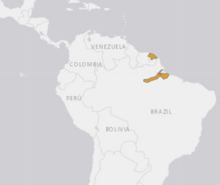Eunectes deschauenseei
| Eunectes deschauenseei | |
|---|---|
| Scientific classification | |
| Kingdom: | Animalia |
| Phylum: | Chordata |
| Class: | Reptilia |
| Order: | Squamata |
| Suborder: | Serpentes |
| Family: | Boidae |
| Genus: | Eunectes |
| Species: | E. deschauenseei
|
| Binomial name | |
| Eunectes deschauenseei | |

| |
| Dark spotted anaconda natural range | |
Eunectes deschauenseei, commonly known as dark-spotted anaconda[1][3] or De Schauensee's anaconda,[4] is a boa species endemic to northeastern South America. No subspecies are currently recognized.[3] Like all boas, it is a non-venomous constrictor.
Taxonomy[]
The specific name, deschauenseei, is in honor of American ornithologist Rodolphe Meyer de Schauensee,[5] who donated a specimen to the Philadelphia Zoo in 1924.[3] The type locality given is "probably collected on the island of Marajo at the mouth of the Amazon".[2]
Distribution and habitat[]
Eunectes deschauenseei is found in South America, in north Brazil (Pará and Amapá states) and French Guiana.[1][3] E. deschauenseei is a semi-aquatic species usually found in swampy, seasonally flooded freshwater areas at elevations below 300 m (980 ft).[1]
Description[]
Adult males measure 130–211 cm (51–83 in) and adult females 120–231 cm (47–91 in) in snout–vent length.[6]
Reproduction[]
Vitellogenesis in E. deschauenseei probably occurs from autumn to spring (May to December). Gestation may last as long as nine months. Litter size among five gravid females ranged from 3 to 27 (mean 10.6). Newborns measure 29–53 cm (11–21 in) in snout–vent length.[6]
Conservation[]
The savanna habitat of E. deschauenseei is highly threatened by agricultural expansion, but the threat posed on this species is not known.[1]
References[]
- ^ a b c d e Dirksen, L.; Oubotar, P. (2021). "Eunectes deschauenseei". IUCN Red List of Threatened Species. 2021: e.T176262A18978500. doi:10.2305/IUCN.UK.2021-2.RLTS.T176262A18978500.en. Retrieved 20 November 2021.
- ^ a b McDiarmid, R. W.; Campbell, J. A.; Toure, T. (1999). Snake Species of the World: A Taxonomic and Geographic Reference. Vol. 1. Washington, District of Columbia: Herpetologists' League. ISBN 1893777014.
- ^ a b c d Eunectes deschauenseei at the Reptarium.cz Reptile Database. Accessed 10 September 2018.
- ^ Smith, Hugo (director), "Amazon Anaconda", Mark O'Shea Official Website, retrieved 1 December 2008
- ^ Beolens, Bo; Watkins, Michael; Grayson, Michael (2011). The Eponym Dictionary of Reptiles. Baltimore: Johns Hopkins University Press. p. 70. ISBN 978-1-4214-0135-5.
- ^ a b Pizzatto, Lígia & Marques, Otavio A. V. (2007). "Reproductive ecology of Boinae snakes with emphasis on Brazilian species and a comparison to pythons". South American Journal of Herpetology. 2 (2): 107–122. doi:10.2994/1808-9798(2007)2[107:reobsw]2.0.co;2.
Further reading[]
| Wikimedia Commons has media related to Eunectes deschauenseei. |
- Dirksen, Lutz; Henderson, Robert W. (2002). Eunectes deschauenseei. Catalogue of American Amphibians and Reptiles. pp. 755.1–755.2. hdl:2152/44652.
- Dirksen, Lutz (2002). Anakondas. Monographische Revision der Gattung Eunectes (Wagler, 1830) (in German). Münster: Natur und Tier-Verlag. ISBN 3-931587-43-6.
- Dirksen, Lutz (2002). "Zur Kenntnis der Anakonda-Arten (Serpentes: Boidae: Eunectes ). I. Eunectes deschauenseei Dunn & Conant, 1936". Herpetofauna (in German). Weinstadt. 21 (122): 12–21.
- Dunn, Emmett R.; Conant, Roger (1936). "Notes on Anacondas, with Descriptions of Two New Species". Proceedings of the Academy of Natural Sciences of Philadelphia. 88: 503–506. JSTOR 4064198. (Eunectes deschauenseei, new species).
- IUCN Red List least concern species
- Eunectes
- Snakes of South America
- Reptiles of Brazil
- Reptiles of French Guiana
- Reptiles described in 1936
- Taxa named by Emmett Reid Dunn
